_________________
George Jenne Various (2017)
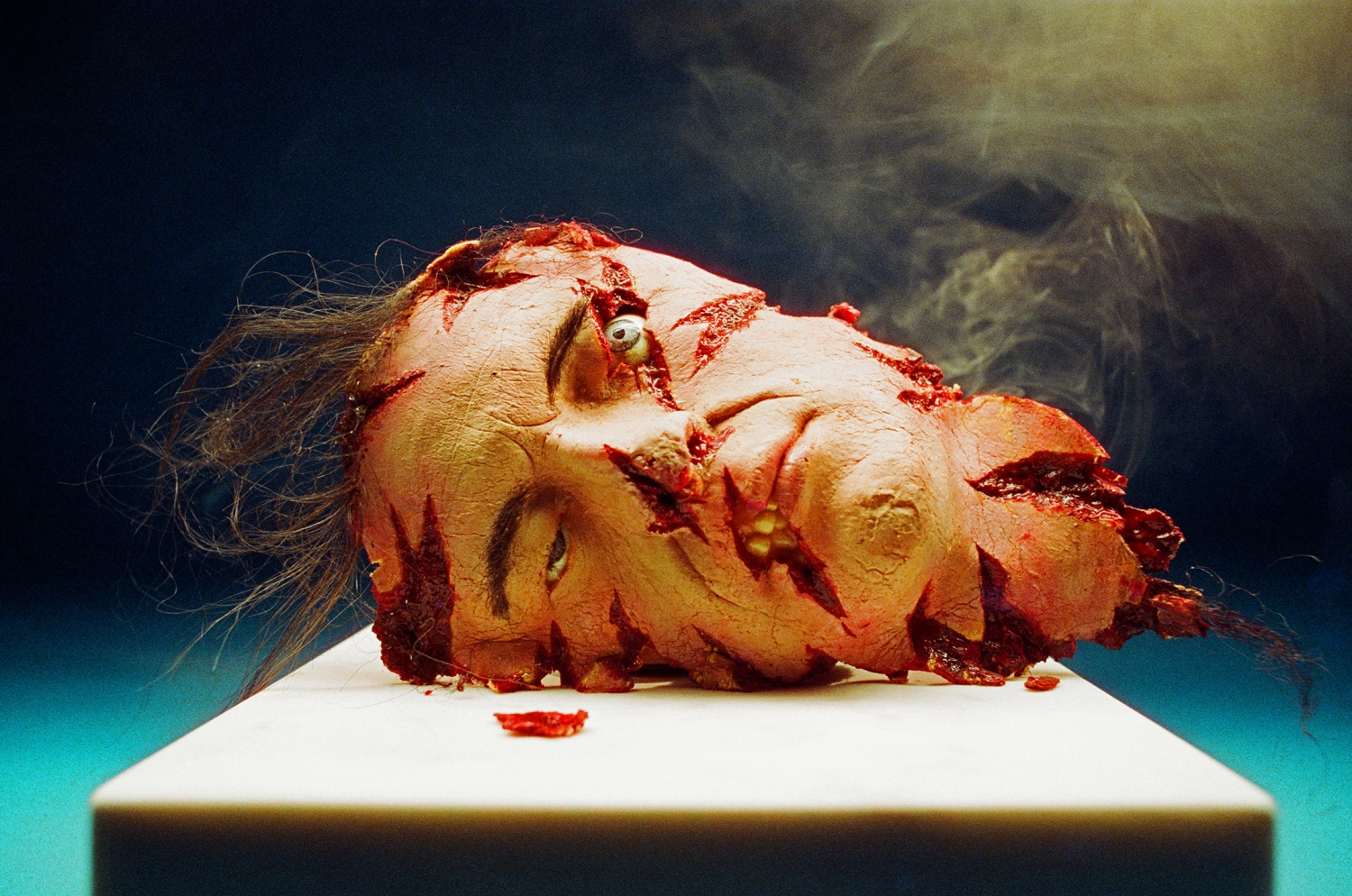
High School Props Series: Prop Bite Face
Mine Eyes Have Seen the Gory (excerpt)

High School Props Series: Prop Drowned Face
_________________
Claudia Alvarez Kids with Guns (2010 – 2012)
‘Deeply affected by the terminally ill children and elderly patients I encountered as a non-emergency ambulance driver, my painted and sculpted figures imbue sculptures of children with adult characteristics and mannerisms.’
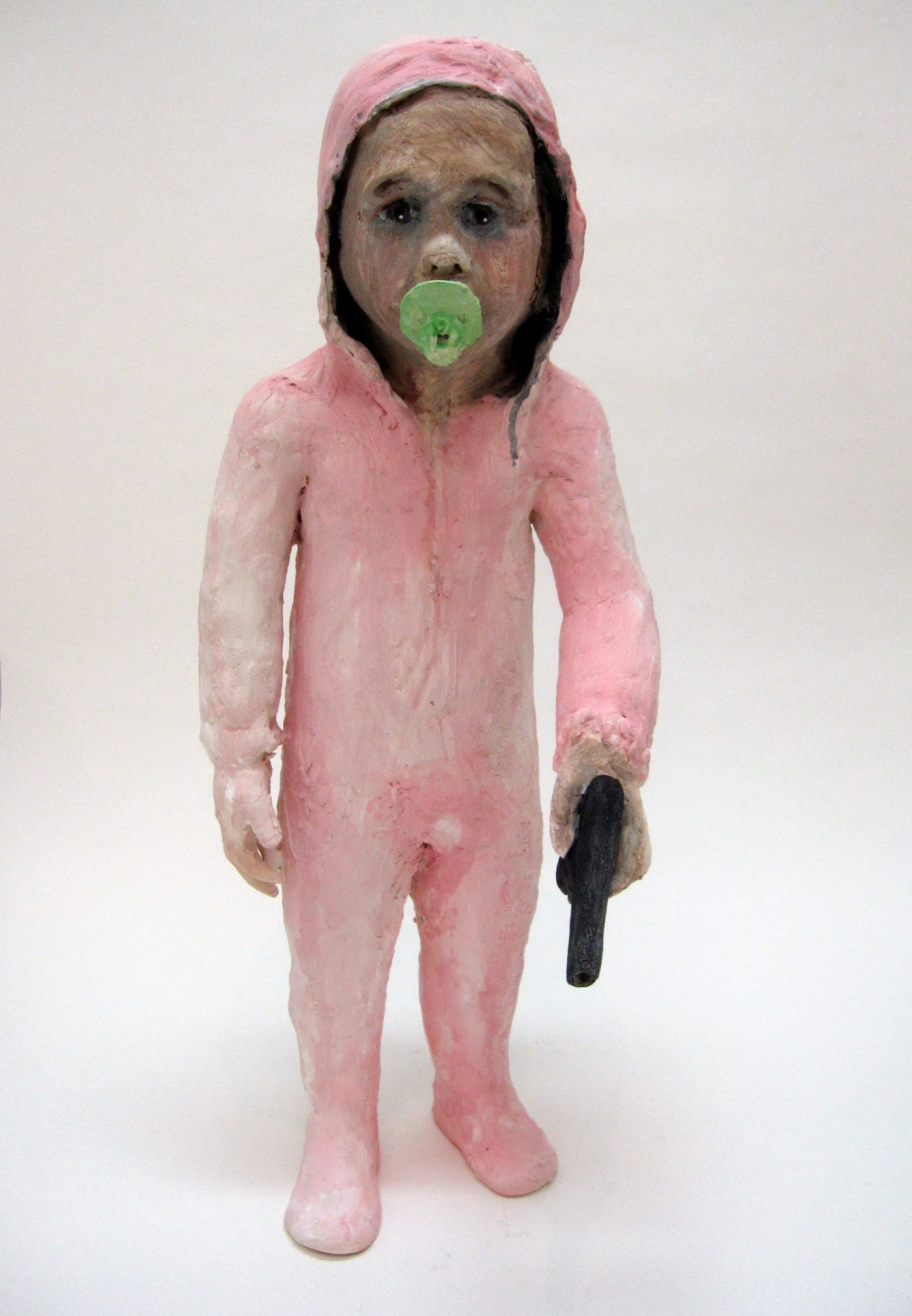


_______________
Pipilotti Rist (Entlastungen) Pipilottis Fehler ([Absolutions] Pipilotti’s Mistakes) (1988)
‘It is a nightmare; it is torture enacted over and again before the viewer’s eyes. In multiple sequences one observes the video’s female protagonist struggling against physical and psychological impediments; the physical struggles en- acted on screen are accompanied by voice-overs that speak directly to the irreconcilable gap between the woman’s efforts and reality. In one sequence the woman faints repeatedly; in another, she dives into a swimming pool only to have her head forced under water as she breaks the surface; in yet another she attempts to climb over a fence, but falls before she can propel herself over to the other side. Amidst these failures of action/volition, the video itself fails; the reception is distorted, pixilated beyond the point of verisimilitude and full of static. The woman’s trials are thus obscured from complete representation: the viewer never gets the full story, for neither does one see the woman com- plete her action, nor is one able to view these attempts uninhibited due to the treatment of the video medium itself.’
_______________
Christopher Reynolds The Pleasures of the Table (2012)
Maple butcher block, mixing bowl, metal, 8 chef’s knives, magnetic knife rack, 8 aprons, metal hooks.


_______________
Brody Condon DeRez FX.Kill RamDass (2005)
_______________
Aida Makoto Edible Artificial Girls (2001)
‘Thank you for your shopping. Have a nice day. It all started in the year 3000 when mankind was tormonted with hunger caused by worldwide food shortages. The founder, old Aida, a molecular biologist, was distressed at the seriousness of the situation, and devoted himself day and night to his studies. Finally, he achieved a great breakthrough in generating a brandnew creature called “Edible Artificial Girls Mimi” derived from the DNA of colitis germs.
‘Mimi is very savory and rich in nutrition which the name implies. (The character pronounced Mimi is a rhyme of Bimi which denotes deliciousness.) Mimi was served all over the world. People were also touched by Mimis lovely appearance, and innocent nature, her only intention being a devotion to giving herself to fulfilling the apettite of the men. Her pure heart would be worth comparing with the hare in the ancient Indian who is said to throw its body into the fire and to become a star in the night sky.
‘Mimi with no sense of pain, and no fear of death by nature is also regarded as an ideal creature for food from the viewpoint of the humanitarian. After the emergence of Mimi, the bad habit of eating the meat of farm animals died out. Mimi, who can be your good companion or kept in food storage, has taken a firm hold within our life-style in the role of a pet. With the great development of new flavors, we can now count more than five thousand varieties of Mimi. Mimi provides most of food on the earth.’
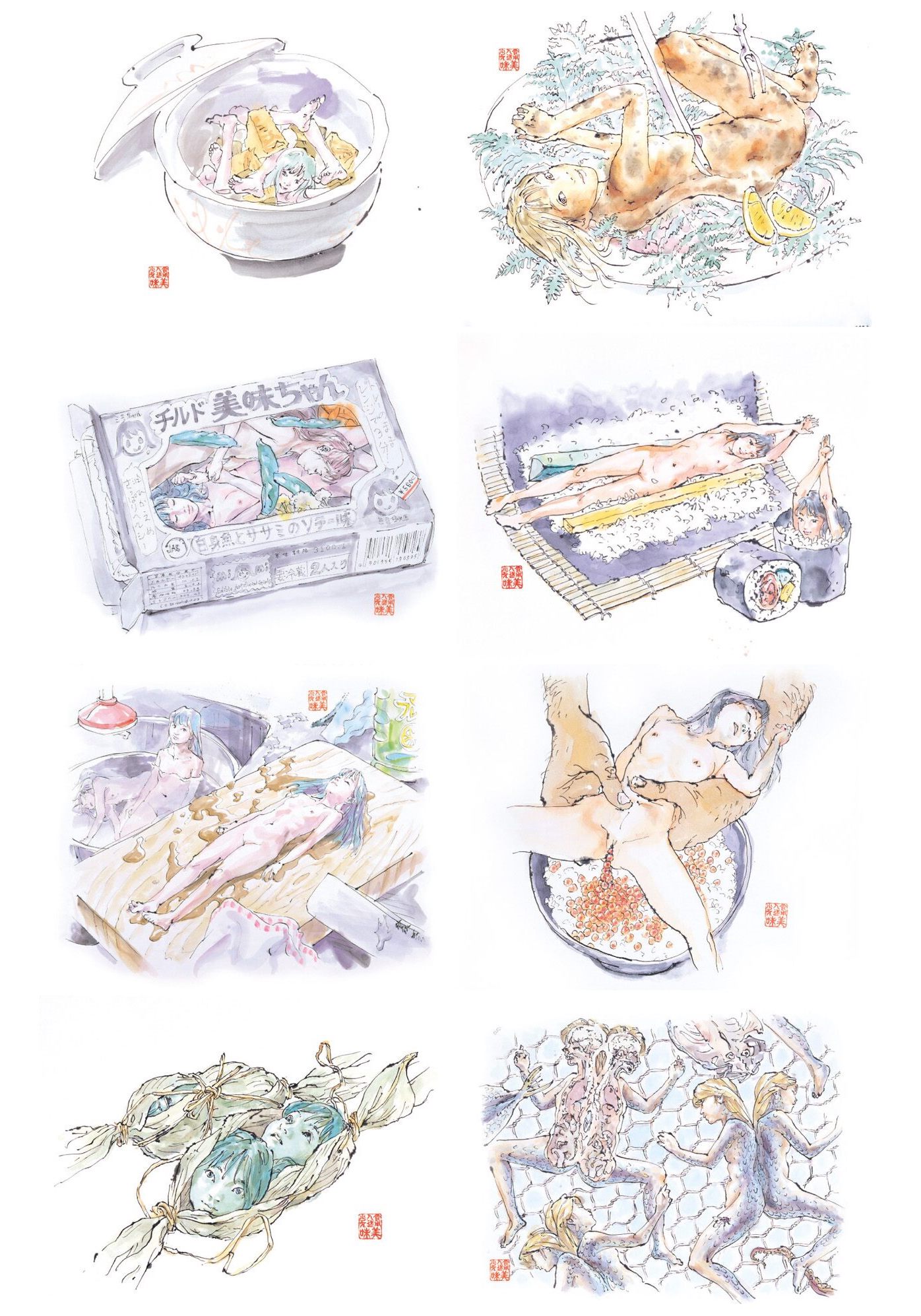
_______________
Tessa Farmer Various (2017 – 2019)
‘In Tessa Farmer’s world a mummified cat can become an entertainment complex for fairies and bugs.’




_________________
Blobby Barack Cooch (2017)

_________________
Olga Balema Cannibals (2015)
‘The sculptures here have ingested other former sculptures, a literal enactment of cannibalism. The round bellies of some are greedy and full, pregnant from autoerotic absorption. The latex skin of others is concave around the scaffolding of sharp and unnatural growths. Ingestion threatens the crucial fiction that subjects are autonomously contained selves, distinct from their environments, agents of their own interiority. As food moves through bodies, exterior becomes interior and vice versa; object constitutes subject and vice versa.’
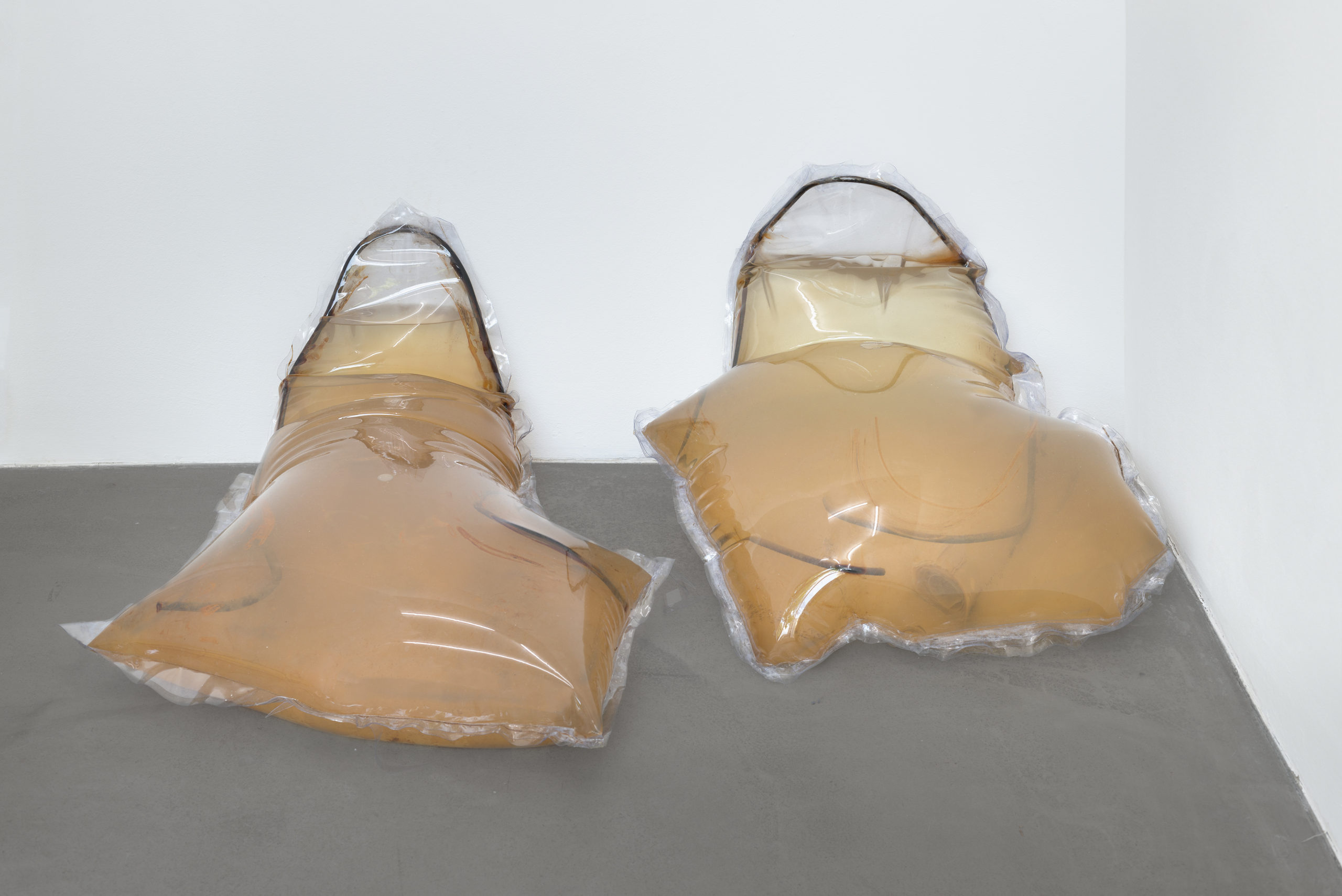

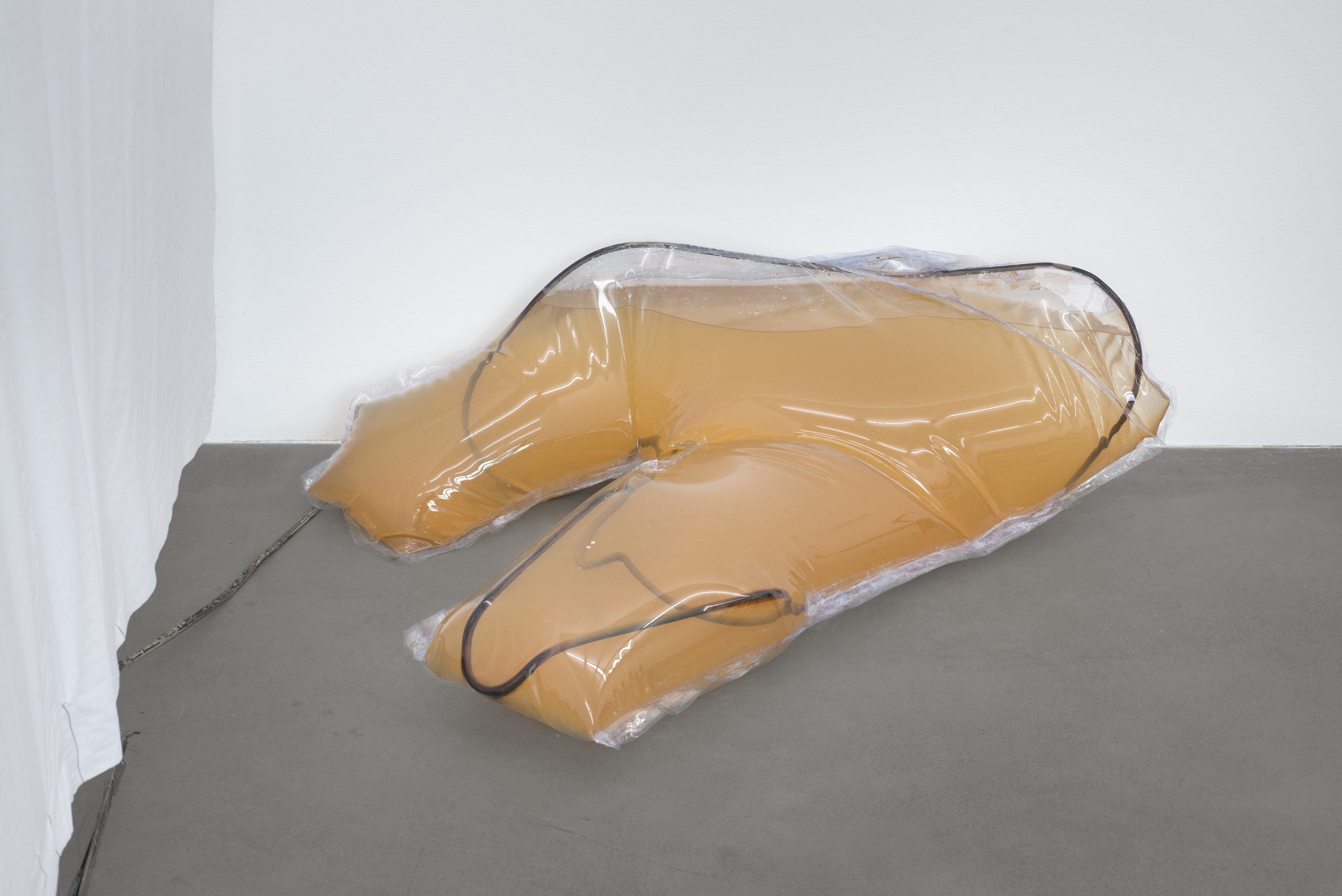
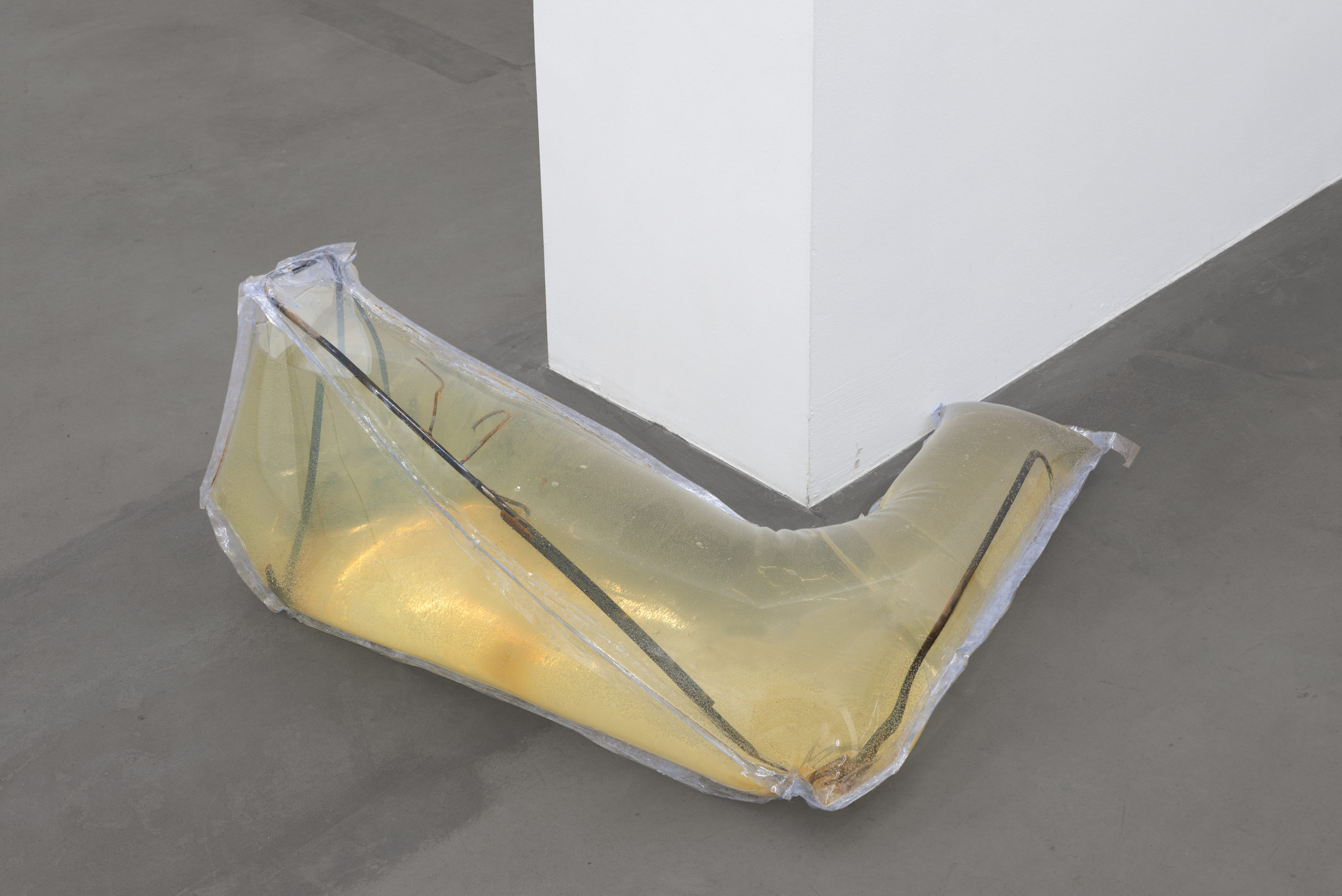

______________
Lindsay Seers Swallowing Black Maria (2009)
‘Seers shows a semi-autobiographical, quasi-documentary film about her life, screened in a mock-up shed whose design is a copy of Thomas Edison’s Black Maria, his New Jersey film studio. The story is implausible, troubling, and beautifully told by ventriloquist dummy narrators. As I staggered out, someone muttered “What is she on?”‘
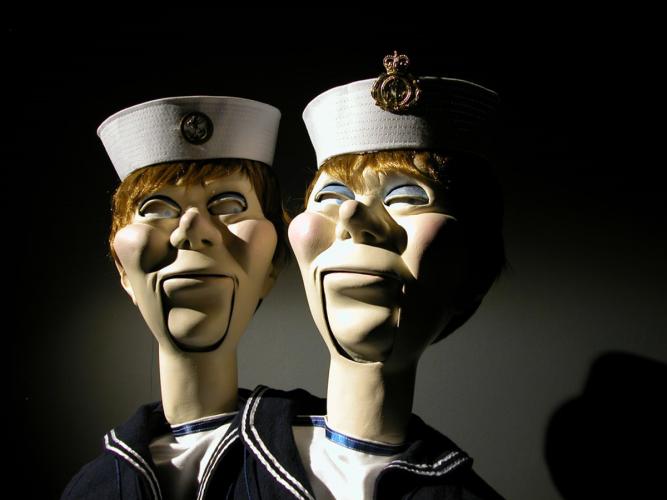

______________
Bagrad Badalian Insanity (2011)



_______________
Chris Kerich etk_i-series/cliff (2017)
‘This project, inspired by the YouTube series Car Boys, involved the creation and destruction of kinetic sculptures in the driving game BeamNG.drive (with a few modifications). BeamNG is built to be a vehicle simulator and racing game, allowing its users to customize cars and race and crash them with realistic soft body physics. It also includes an editor, to allow players to create their own levels and scenarios to race in. To create this project, I abused the capabilities of the editor to create car-sculptures that often burst into flame immediately or caused the physics engine to severely glitch as soon as the simulation was started. By exploring conditions in the game that would be considered unlikely for an average user (cars dropped from a great height with 100x gravity, cars existing inside of one another) a space is opened up inside of what is otherwise a relatively standard driving simulator to explore and create new things. These zones of alternative creative production are extremely important in helping to explore and understand systems.’

_______________
Unknowns Various Guros (2012-2018)


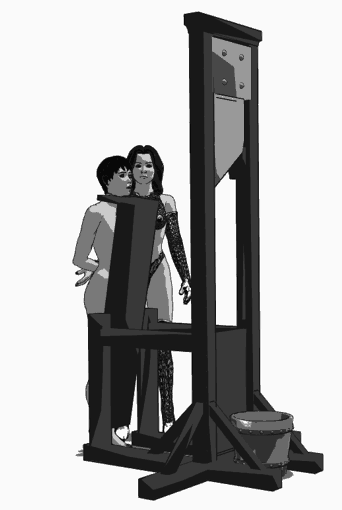


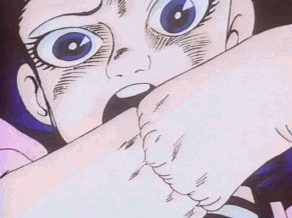


______________
Jim Shaw Dream Object (2004)
‘I think I was half awake when I thought of this upright piano modelled after the cave monster from ‘It Conquered the World.’ Using an old piano with keys sawed off to make the mouth…’

______________
Antonio Cascos Chamizo To Eat or to be Eaten – A Guide to Cannibalism (2015)
‘Intended to promote eating humans, Antonio Cascos Chamizo’s Guide to Cannibalism provides recipes for cooking meat, and also comes with kitchenware embedded with real hair. Combining graphic and product design to challenge a “food taboo”, Chamizo created a fictional scenario in which cannibalism is socially acceptable.’ These facts are presented in a guide, which includes chopping charts for correctly butchering bodies to get the best cuts, and recipes for ways to cook the meat with other foods.




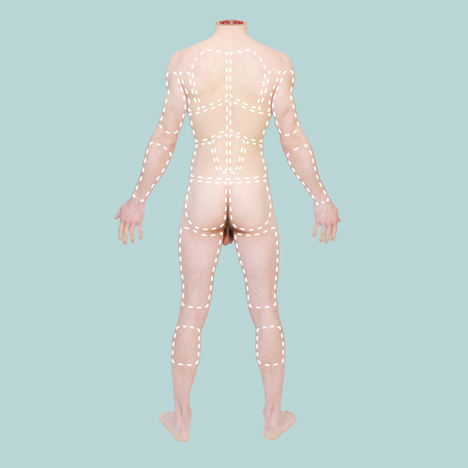
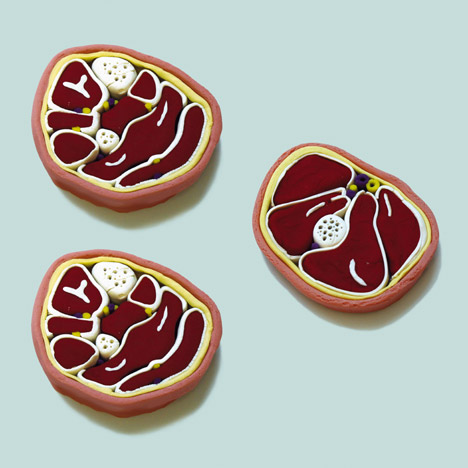
_______________
Hannah Black Aeter (2018)
Aeter (Sam) (excerpt)
Aeter (Jack) (excerpt)
_______________
Ofir Dor Various (2017)
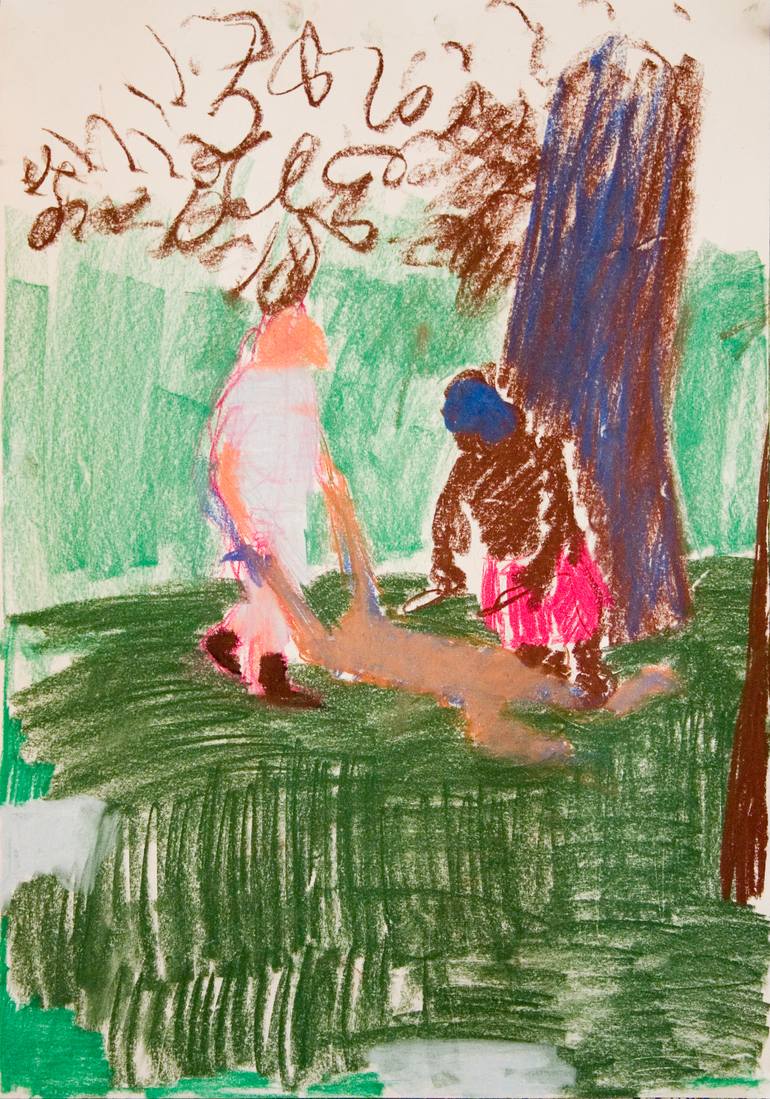
Study for Cannibals

Couple on the Carpet

Study of Children playing under a Tree
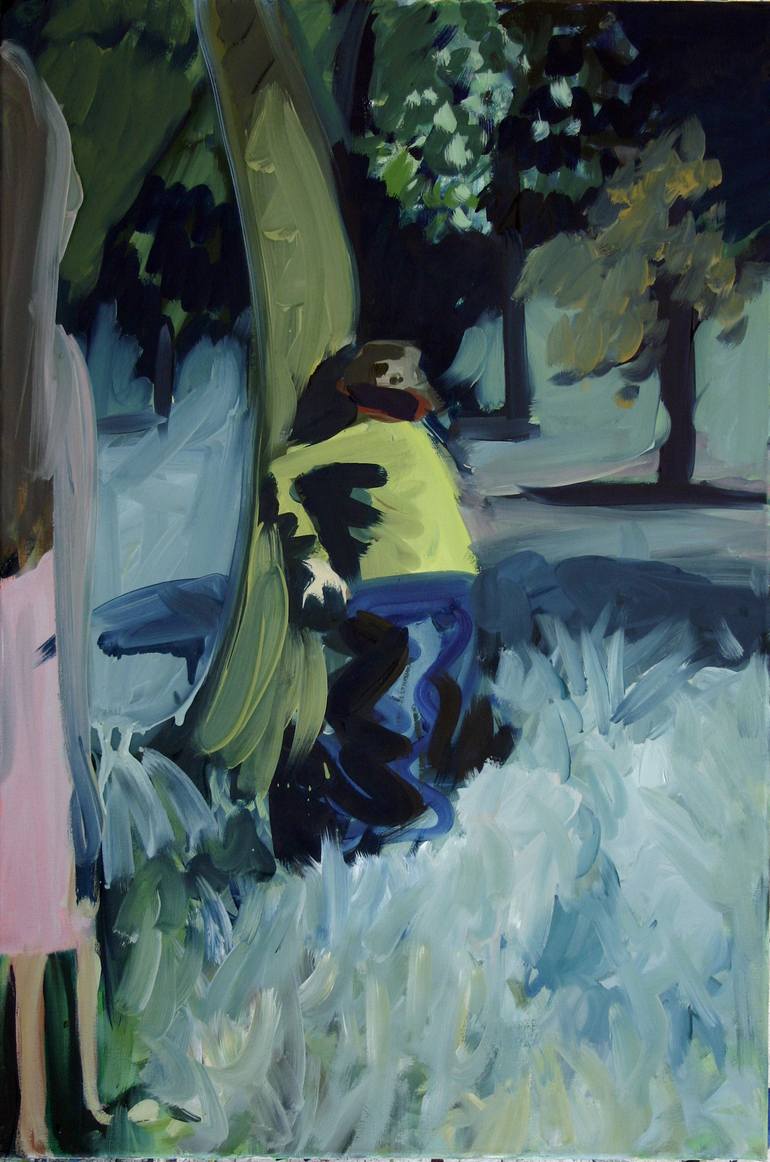
Man Tied to a Tree
_______________
Kristof Kintera I see, I see, I see (2009)
mechanical sculpture
_______________
Sarah and Joseph Belknap Skins (2015)
‘The Belknaps might be best known for the “skins” they’ve made in the past few years, deflated silicone spheres that appear to have been shed by some unassuming moon or one of the exoplanets of deep space. A dozen The skins hang on the walls like so many jackets waiting for a chilly day. To make the skins, Joseph says, they brushed silicone onto a textured foam orb, layer by layer, as a scientist in the field might make a mold, and then they turned each one inside out. They didn’t know in advance exactly what result they’d get. That’s typical of their experimentation with materials, natural and synthetic, including graphite powder, mica flakes, and “lunar regolith simulant” – man-made moon dust.’


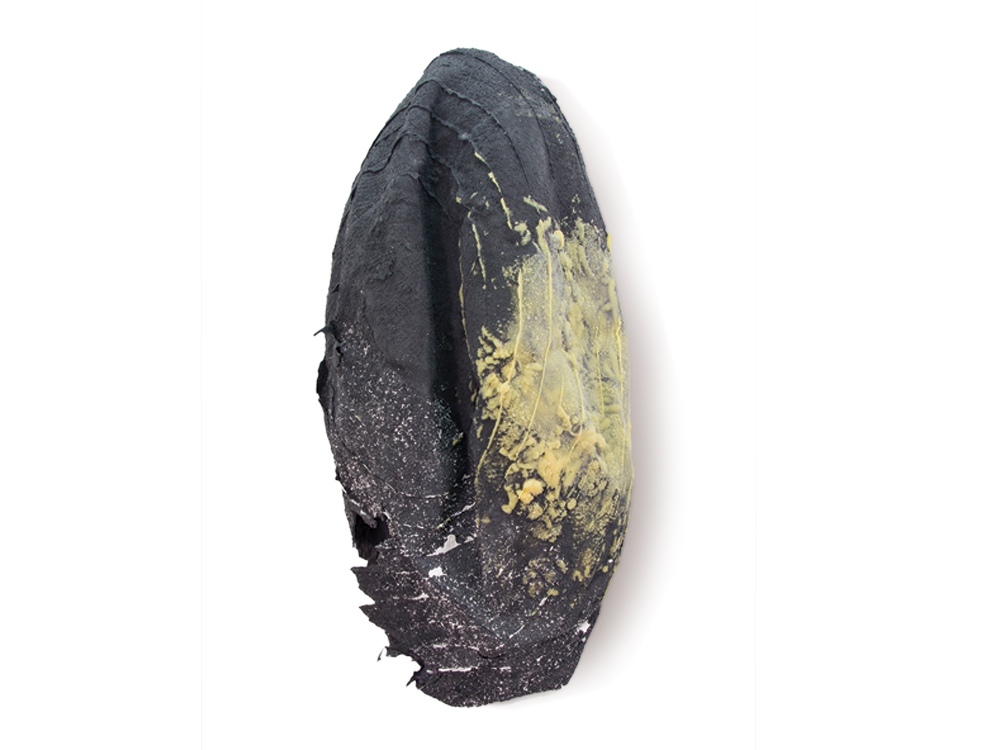
________________
Odd Nerdrum No Witness (2016)
‘In this horrendous piece, one participant fires a gun at the other. The bullet has left the snub-nosed pistol, but it has not yet reached its target. The entire composition is organized so that its brightest point, a cold muzzle-flash, appears blinding. Hair flying, the gunman twists in a single fluid motion, like some heraldic Hermes, so that his pose combines reaching for the holstered pistol, drawing, aiming, and firing. The victim, already bloody from a prior beating, rocks back, though the bullet has not yet hit him.’
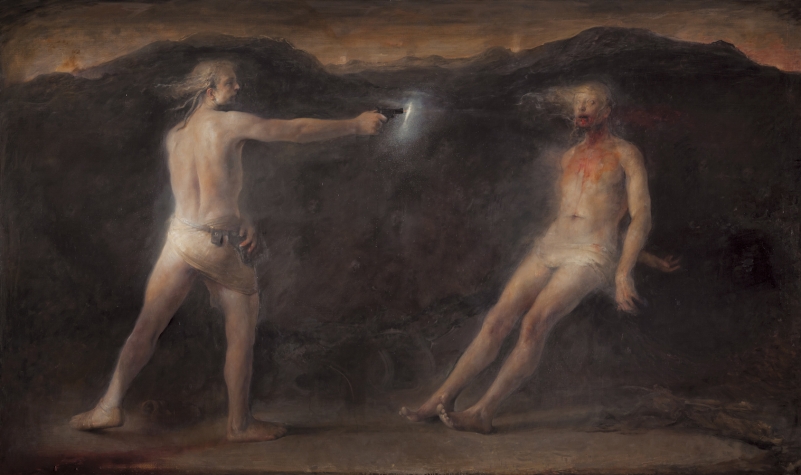
_________________
Eric Manigaud Portraits Clinique (2009)
‘Drawings that transcribe existing photographs operate on a tension between fast (the photograph fixing the image) and slow (the laborious transcription of something seen), and that contradiction is a way of probing our experience of the visual image and its claim to truth.’


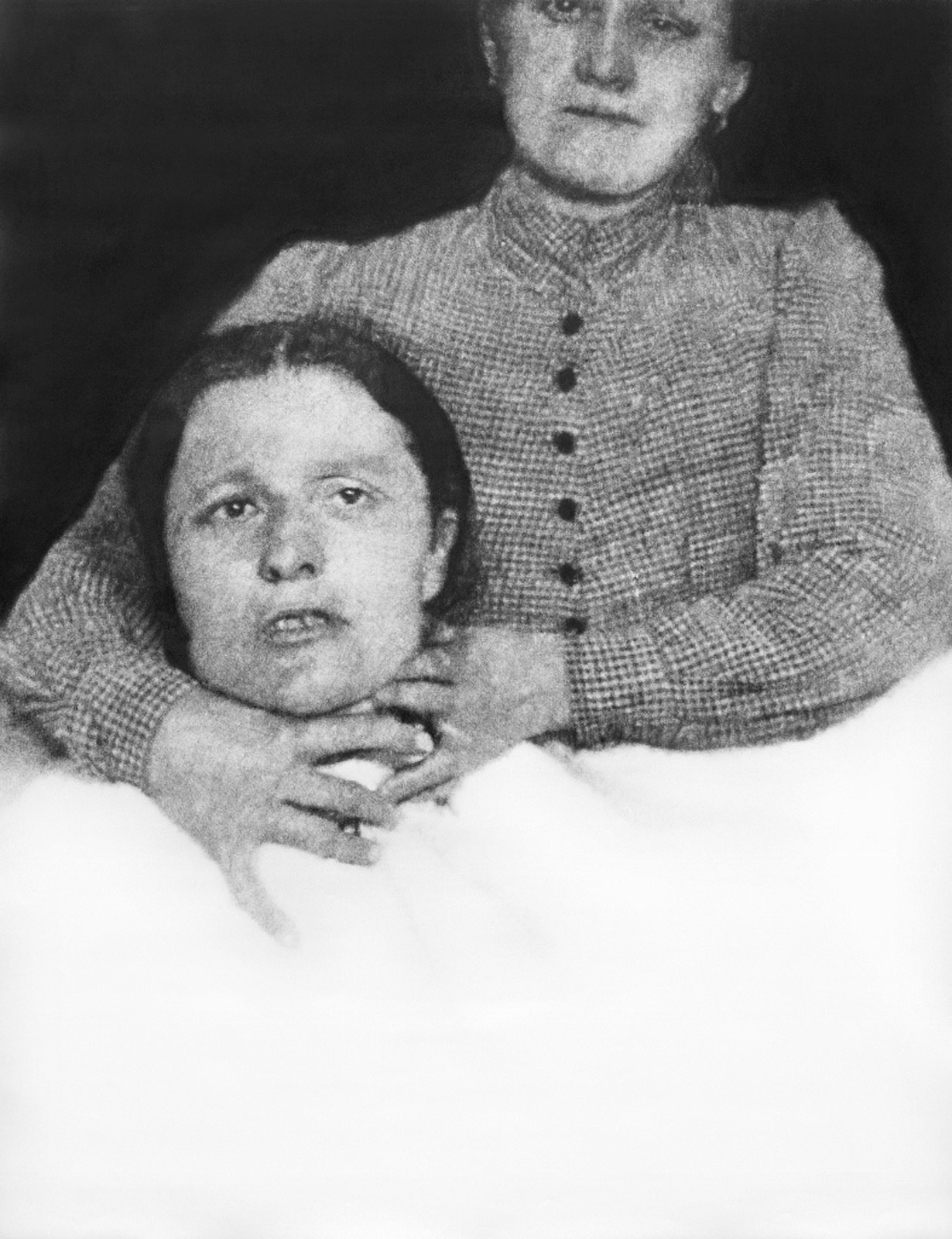
_______________
Zeger Reyers Rotating Kitchen (2013)
‘Artist Zeger Reyers’s latest bit of performance art, “Rotating Kitchen” takes the kitchen mess to a new level. A performer starts preparing a meal for the spectator guests, but takes a brief exit – though perhaps a second too long. The kitchen stage with food half-prepped, mise en place out in the open, and dishwasher running, then begins its ominous rotation. Terrible mashes of food and ingredients plaster the walls, and destruction to short-lived order ensues.’

_______________
Jake And Dinos Chapman Adolf Hitler Golf Art (2012)
‘The Jake and Dinos Chapman work is a statue of the Nazi dictator which salutes and screams “Nein!” when a ball passes through it.The Chapman brothers’ art forms part of the Grundy Art Gallery’s Adventureland Golf exhibition, which features art works as holes on a crazy golf course.’

_______________
Laurie Simmons The Love Doll (2009 – 2011)
‘To create her latest series, the artist Laurie Simmons ordered a high-end Japanese love doll—a life-sized, anatomically correct synthetic female, designed for use as an inanimate sex partner. Her photographs document an evolving friendship, ending with the arrival of a second, new doll.’

Day 1 / Day 27 (New in Box)

Day 8 (Lying on Bed)

Day 22 (20 Pounds of Jewelry)

Day 24 (Underwater)

Day 23 (Kitchen)

Day 25 (The Jump)

Day 30 (Meeting)
_______________
Tony Matelli Lost and sick (1996)
Epoxy resin, plaster and paint
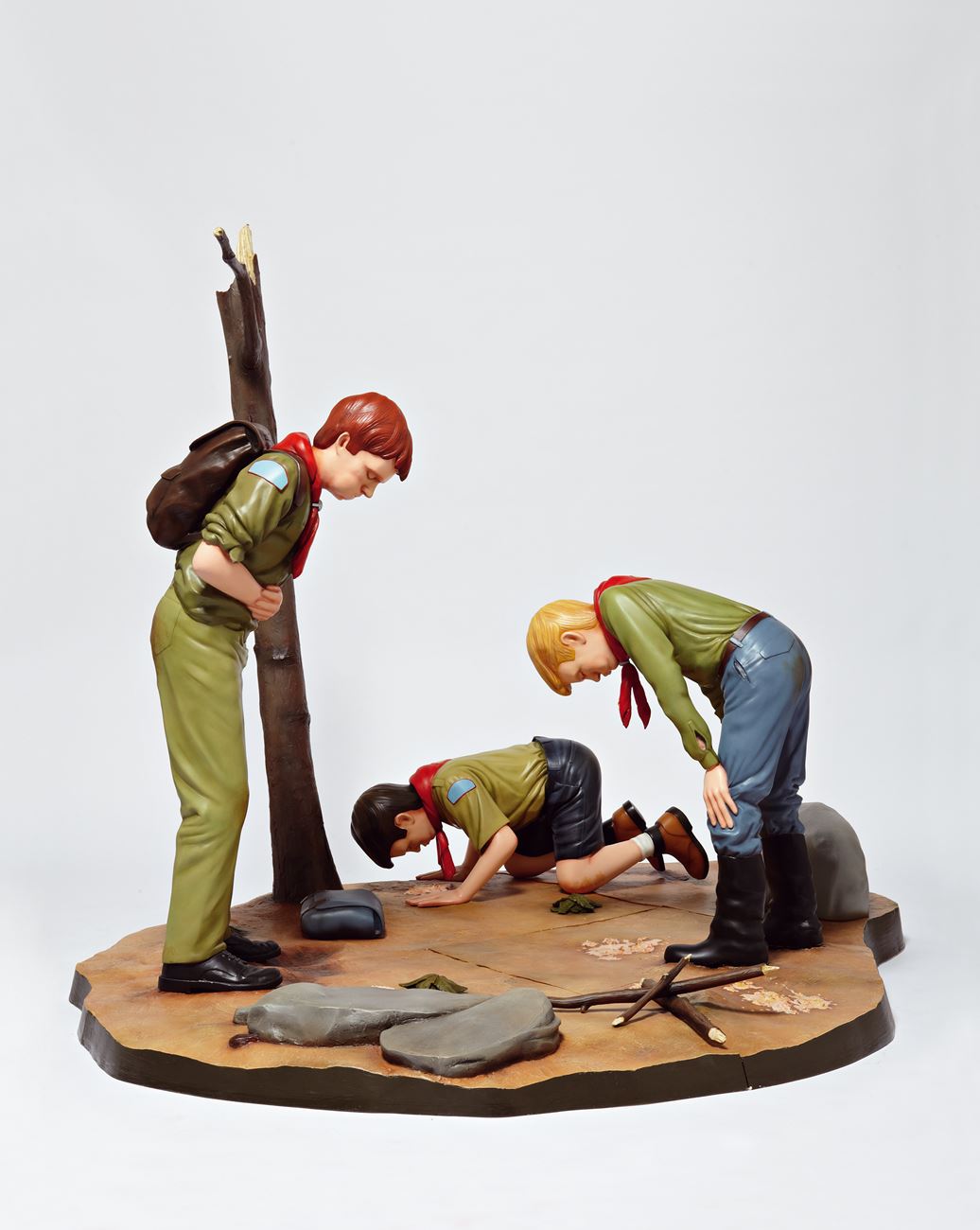
_______________
Charlotte Caron Various (2011)



_______________
Eddie Lohmeyer Scrolling Landscape in 34 NES Games #2 (2020)
‘A work of experimental glitch video that explores the relationship among nostalgia and our perception of technologically mediated landscapes. The film was created by appropriating footage of speedruns of older 8-bit video games and then editing together their scrolling landscapes into a continuously unfolding vista of gameworlds. This landscape has then been corrupted using glitch techniques to generate psychedelic abstractions that rapidly accelerate through two-dimensional space.’
_______________
Johannes Kahrs Various (2004-2015)

Two Men (Kiss) (2008)
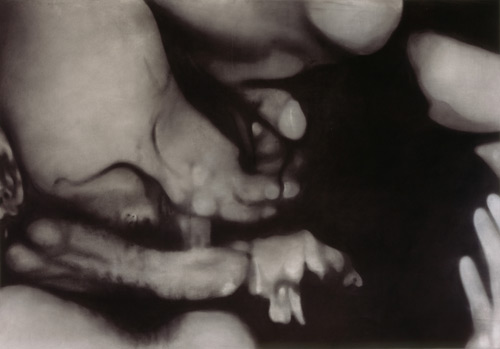
Untitled (2010)
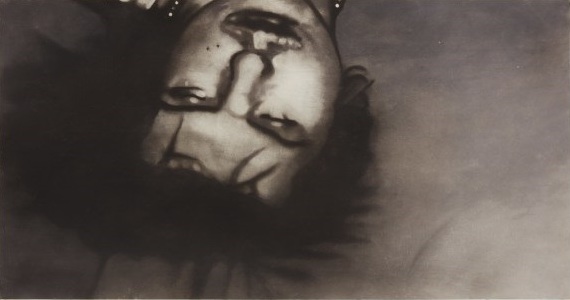
Toter (oben) (2004)

Untitled (embrace) (2015)
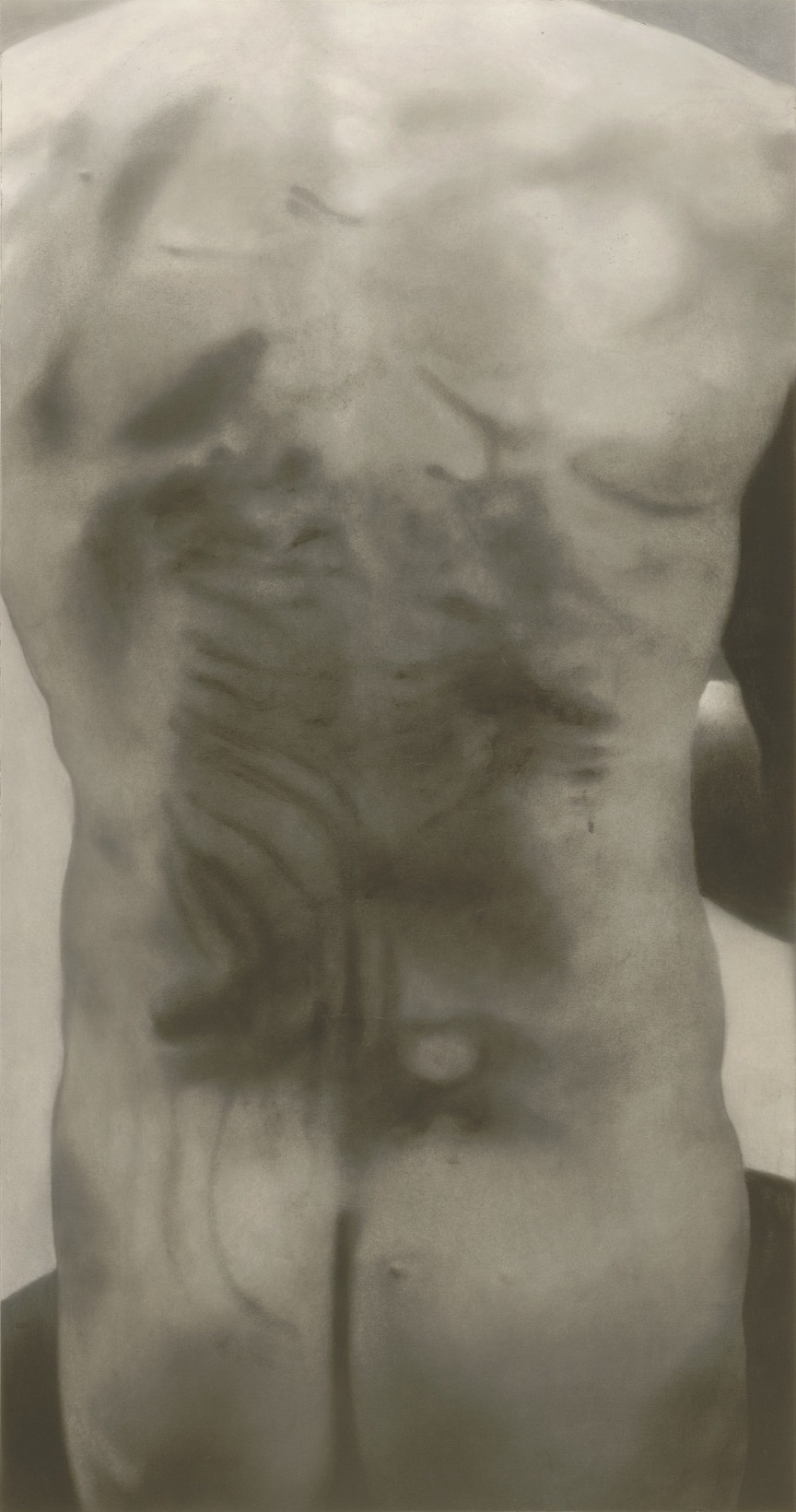
Back (Sunday Afternoon) (2004)
_______________
Kara Güt Intimacy Mod Supercut (2018)
‘Intimacy’s Mod is a series of mods by Kara Gut created with the aid of the “Immersive Lover’s Comfort” by flexcreator for Skyrim. By using this mod, the artist distorts the games’ original narrative and replaces it with an in-game performance carried out by the Gut herself (via her avatar) and one NPC (Non Player Character). Through the Intimacy Mod, Gut wanted to highlight the “cynicism and brutality (unintended or otherwise) of modding culture as a metaphor for our post-digital society at large, creating arresting situations of forced intimacy within a hyper-real space.”‘
_______________
Fábio Magalhães Cut Bodies (2015-2016)
‘For Brazilian artist Fábio Magalhães’ hyperrealist oil paintings, the more grotesque the better. Using gruesome body horror imagery such as hacked up, barely identifiable body parts and suffocated faces in plastic bags, Magalhães’ work is as incisive as it is skillfully rendered. The breaking down of recognizably human appendages and entrails into chopped up, stomach churning chunks is purposefully reminiscent of a real-life counterpart: that of animal cruelty.’

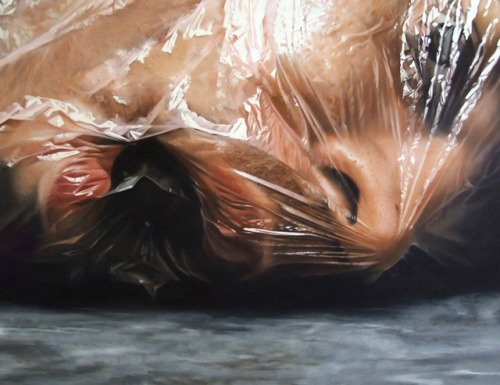
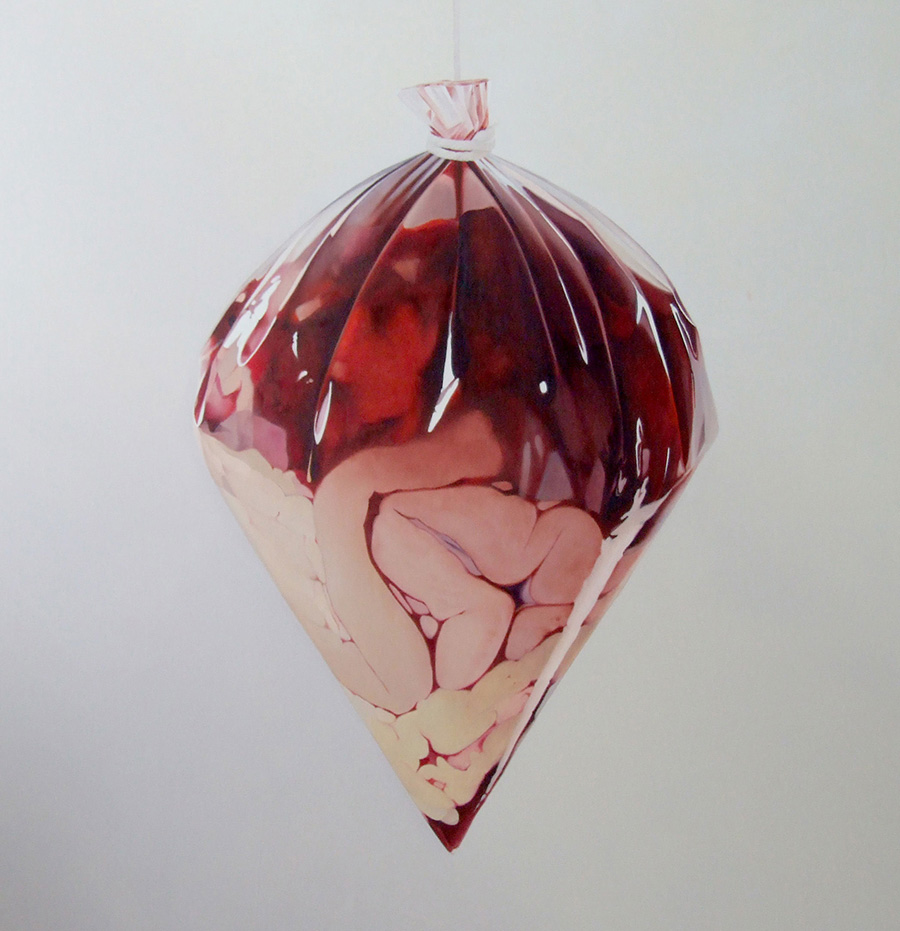
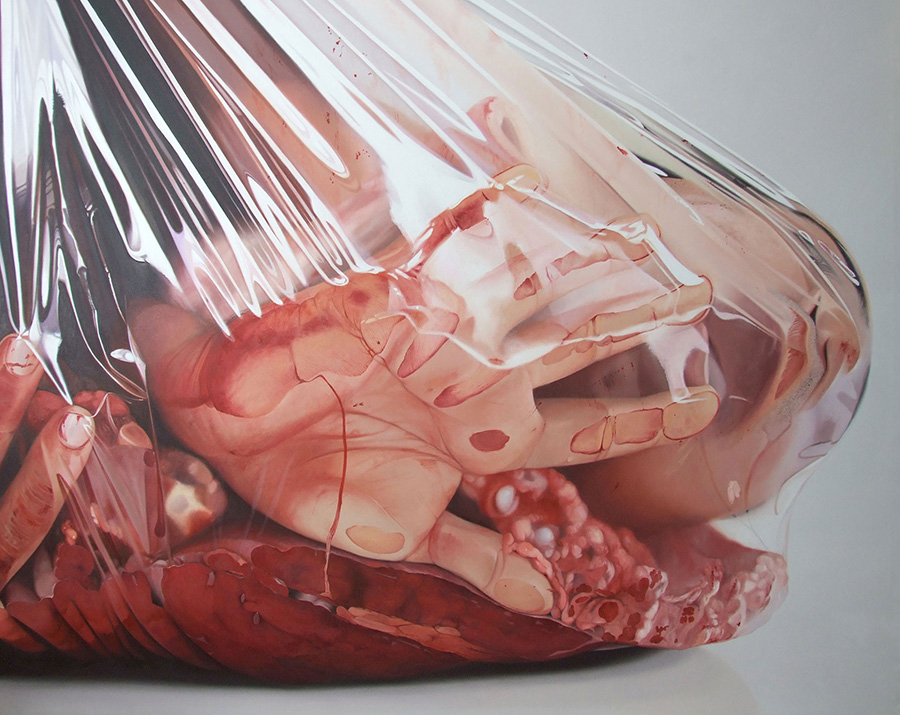
_______________
Huang Yong Ping Leviathanation (2011)
‘Huang Yong Ping’s Leviathanation is a life-size train carriage with a gigantic fiberglass fish head mounted on the front, out of which sprout stuffed animals.’
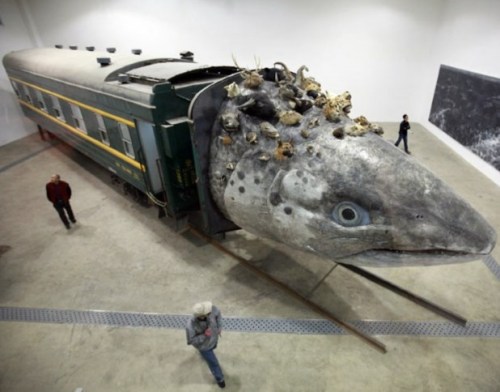

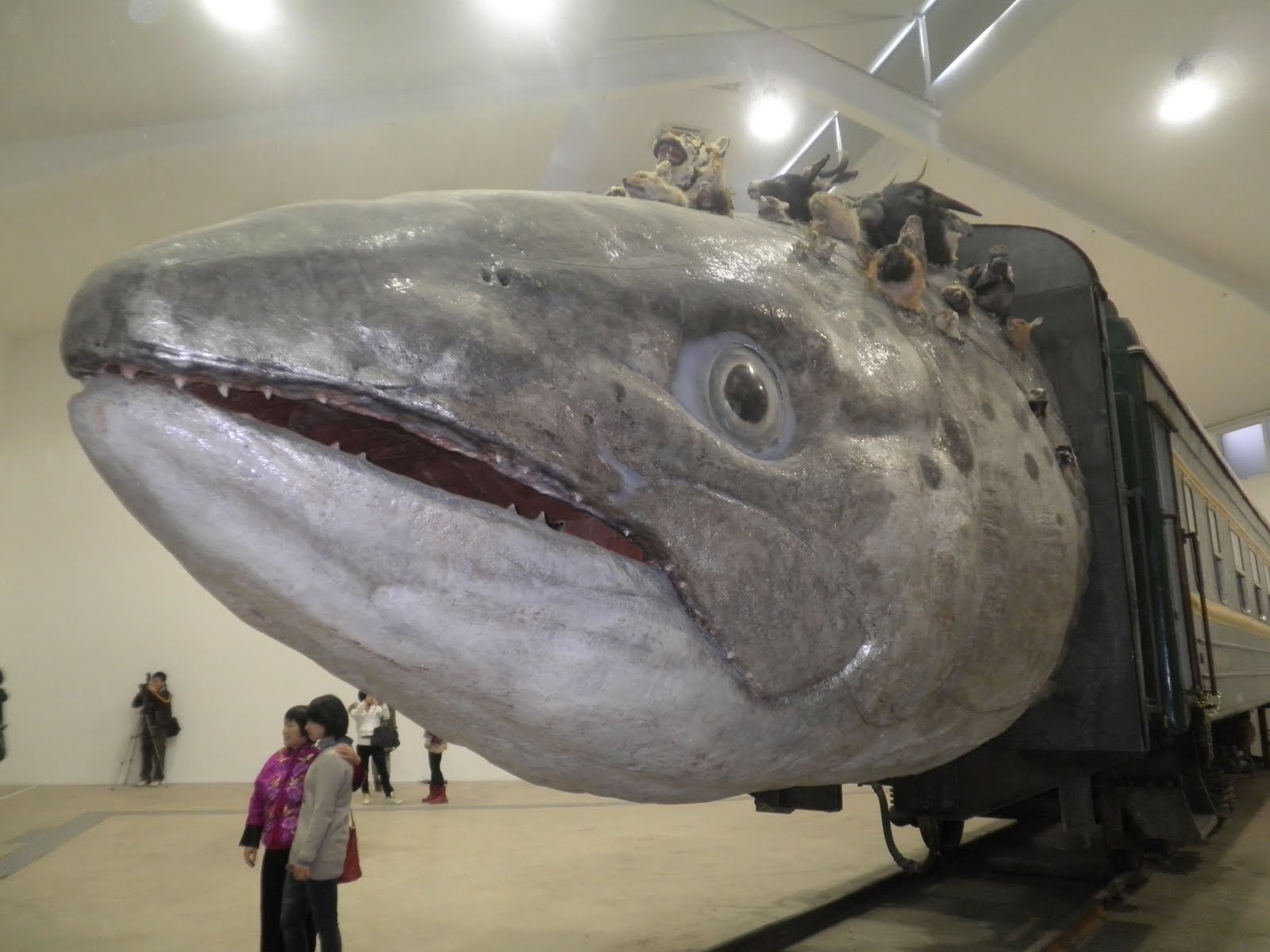
_______________
Cornelia Parker Shared Fate (Oliver) (1998)
‘Here is a doll cut in half by the Guillotine that beheaded Marie Antoinette.’
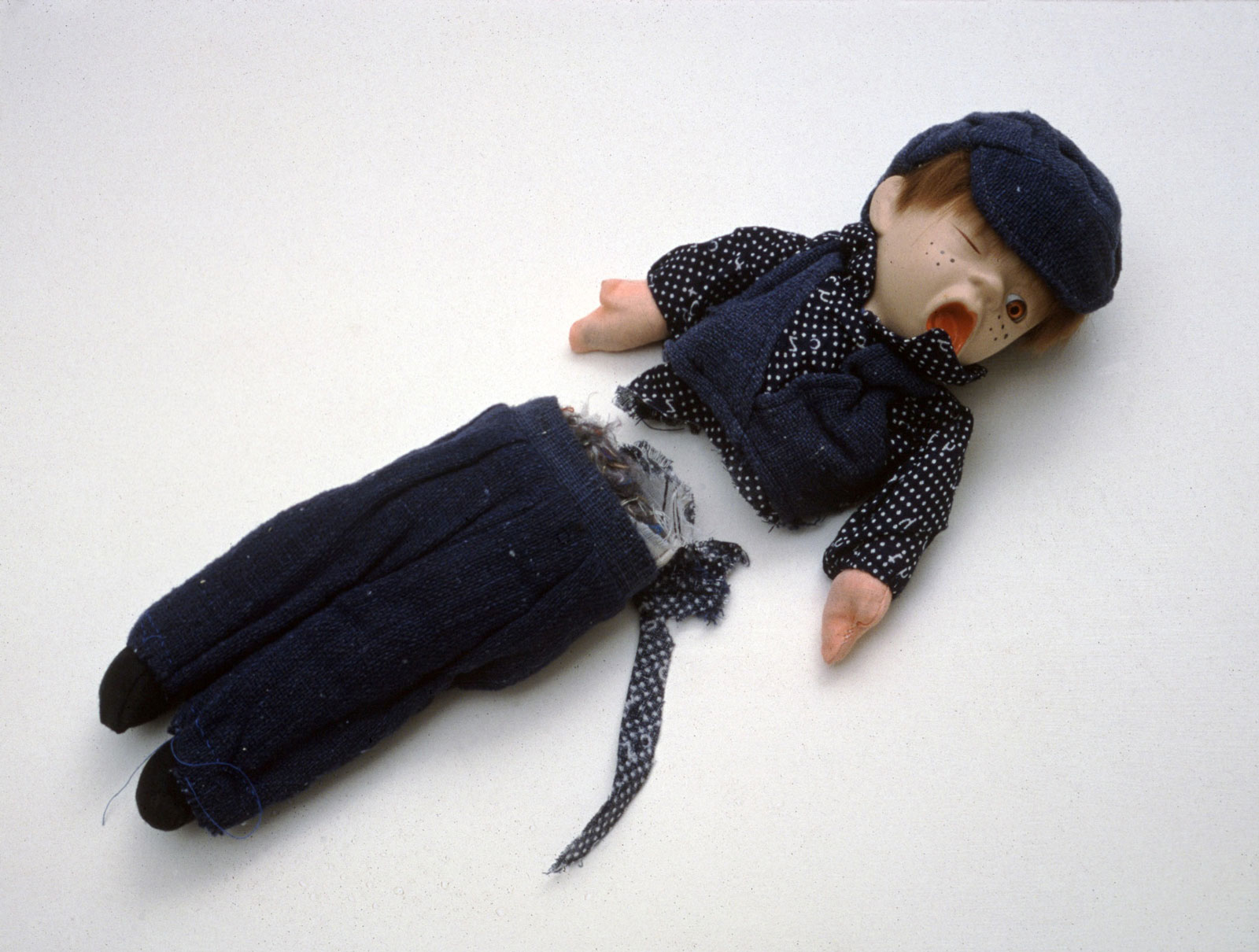
_______________
Michaël Borremans Various (2010 – 2018)
‘Much of Michaël Borremans‘ work is composed of people in partial states, often shown as if they were mannequins, all the while still maintaining extremely fleshy and life-like skin tones. Painting primarily with oil paints, his brushstrokes alternate between sketchy fluidity and opaque solidity that contributes to the strange atmosphere of his paintings. Borremans’ style of painting and drawing has been influenced by artists such as Manet, Degas and Velazquez. The figures in the the paintings are devoid of all identity, becoming an archetype.’


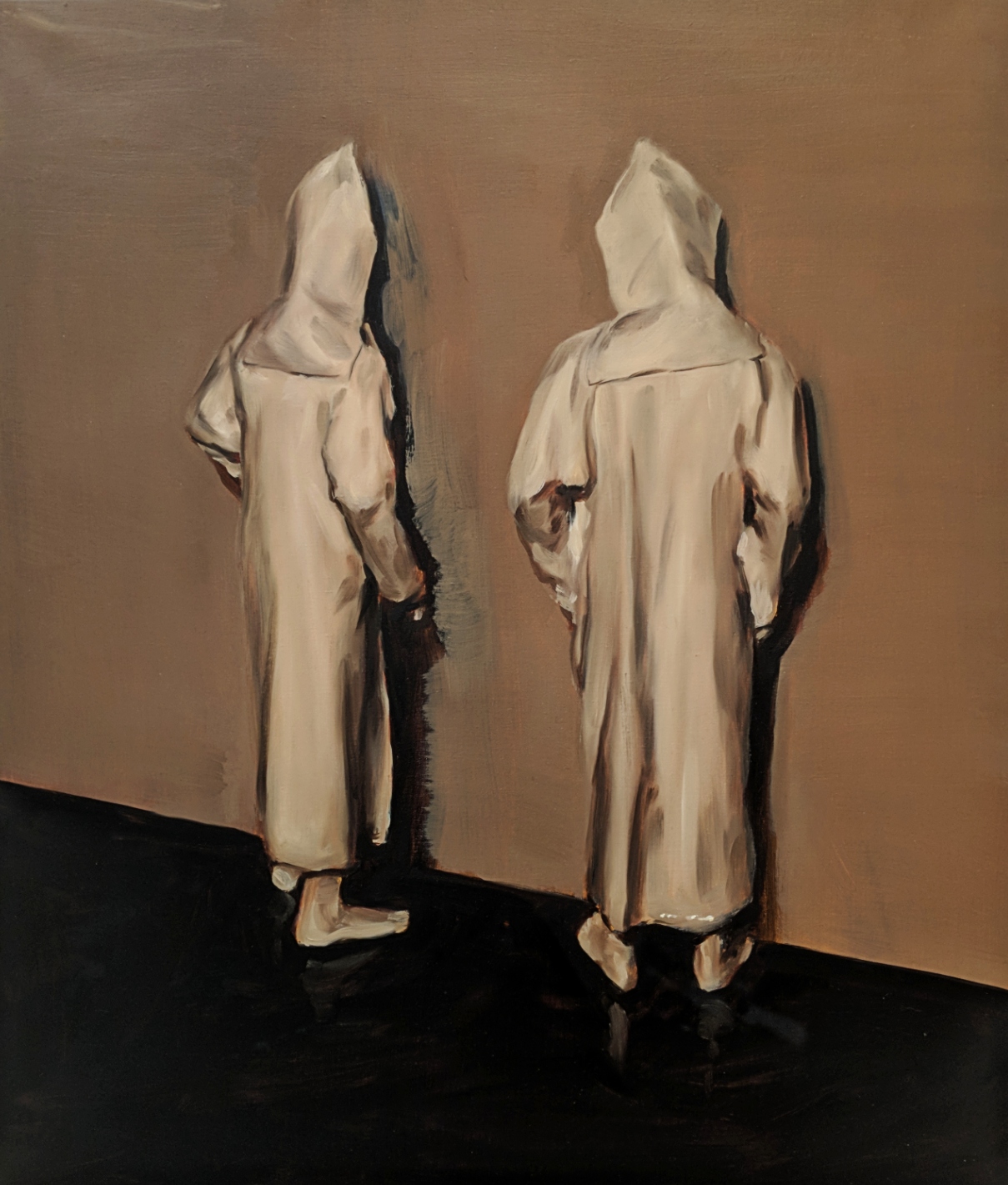

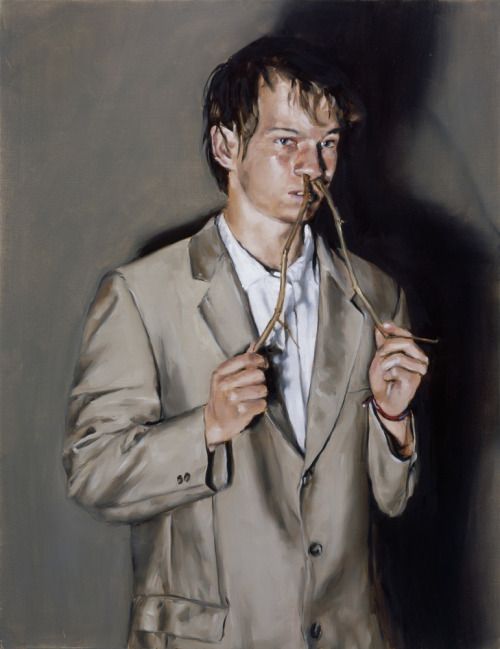
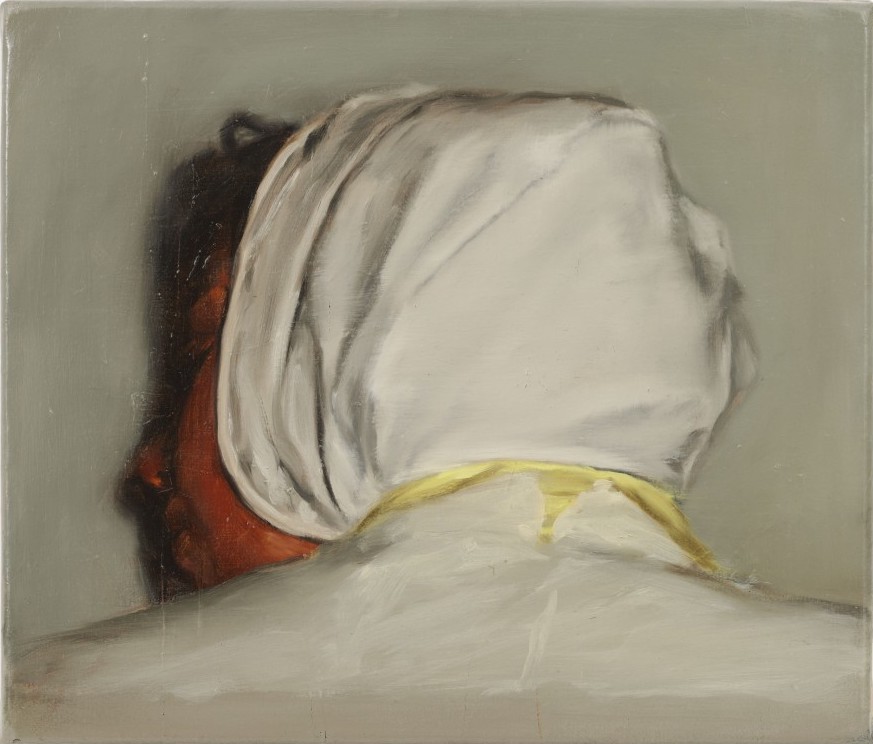
*
p.s. RIP Michel Piccoli ** Milk, Hi, Milk. So happy you enjoyed it. ** David Ehrenstein, Thank you again, sir! Yes, Michel Piccoli, so great, such an incredible body of work. Quite probably the most respected actor in France. RIP Everyone, Should you wish to supplement your experience with Dorothy Dean yesterday, Mr. Ehrenstein recommends these two related tomes: ‘Andy Warhol’s The Chelsea Girls’ and Bill Reed’s wonderful memoir ‘Early Plastic’. ** _Black_Acrylic, Hi, B. Oh, okay, about Eurovision. It’s weird: other than your mention I haven’t seen or read a single thing about it anywhere. Mysterious. ** Thomas Moore, Cool about the welcome post. Would be great, of course! Ah, yeah, Washington was very hard hit. But things seem to be on the track to reopening all over the US whether that’s a good idea or not, so it shouldn’t be too much longer, I think, I hope. I just restored an old guest-post by you for future launching: your intro to Kill Rock Stars if you remember that. xo, me. ** Misanthrope, Thanks for the compliment re: my fishing abilities. The word ‘grind’ can be a plus to whatever it characterises, i.e. ‘bump and grind’, for instance. I was thinking the other day about how forgotten Harold Brodkey is these days. He was such a thing in the 80s and around then. He had this kind of Truman Capote thing going in where he was forever writing a legendarily long-in-the-writing novel whose arrival was much buzzed about for years, and then it (‘The Runaway Soul’) finally came out, and it was kind of received as a dud, if I remember right. Kind of a ‘Chinese Democracy’ kind of thing. And in many recent years, I haven’t seen his name in print or heard it in anyone’s voice at all until you brought him up. I read one of his short story books, and I think read some/most of ‘The Runaway Soul’, but that’s it. Blah blah. ** Steve Erickson, Ever more curious about ‘Capone’. Hm, ‘stomps on’? That seems maybe harsh? I haven’t seen the film in years, though, and, it being a fiction, a film, I have a tendency to see unpleasant attitudes in art as interesting factors/drawbacks to be taken into account, especially when it’s a film or book or whatever that’s from long enough ago that it has no real power to influence people’s attitudes within the context in which it’s being judged. Something like that. ** Right. Today’s post is cool. There’s some good stuff in there. Find it if you want. See you tomorrow.
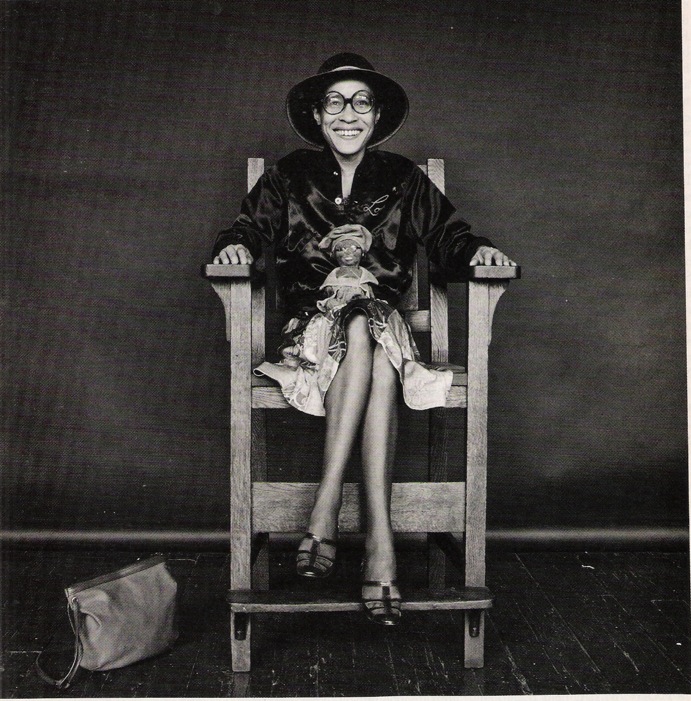
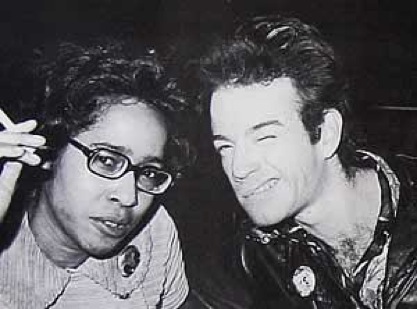
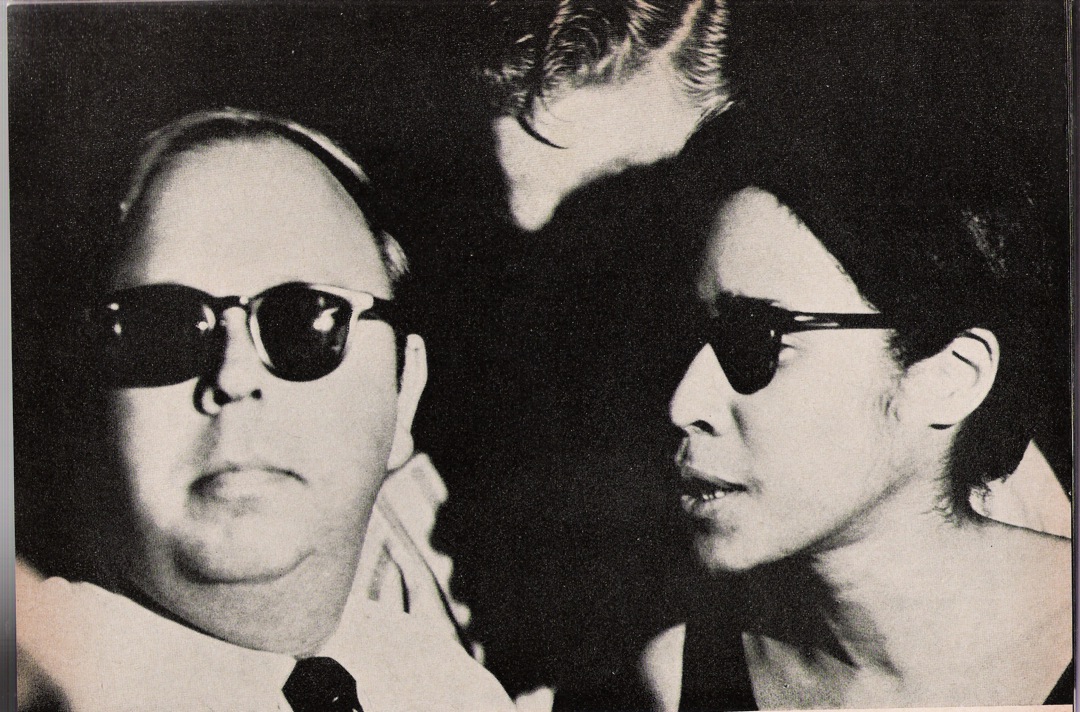
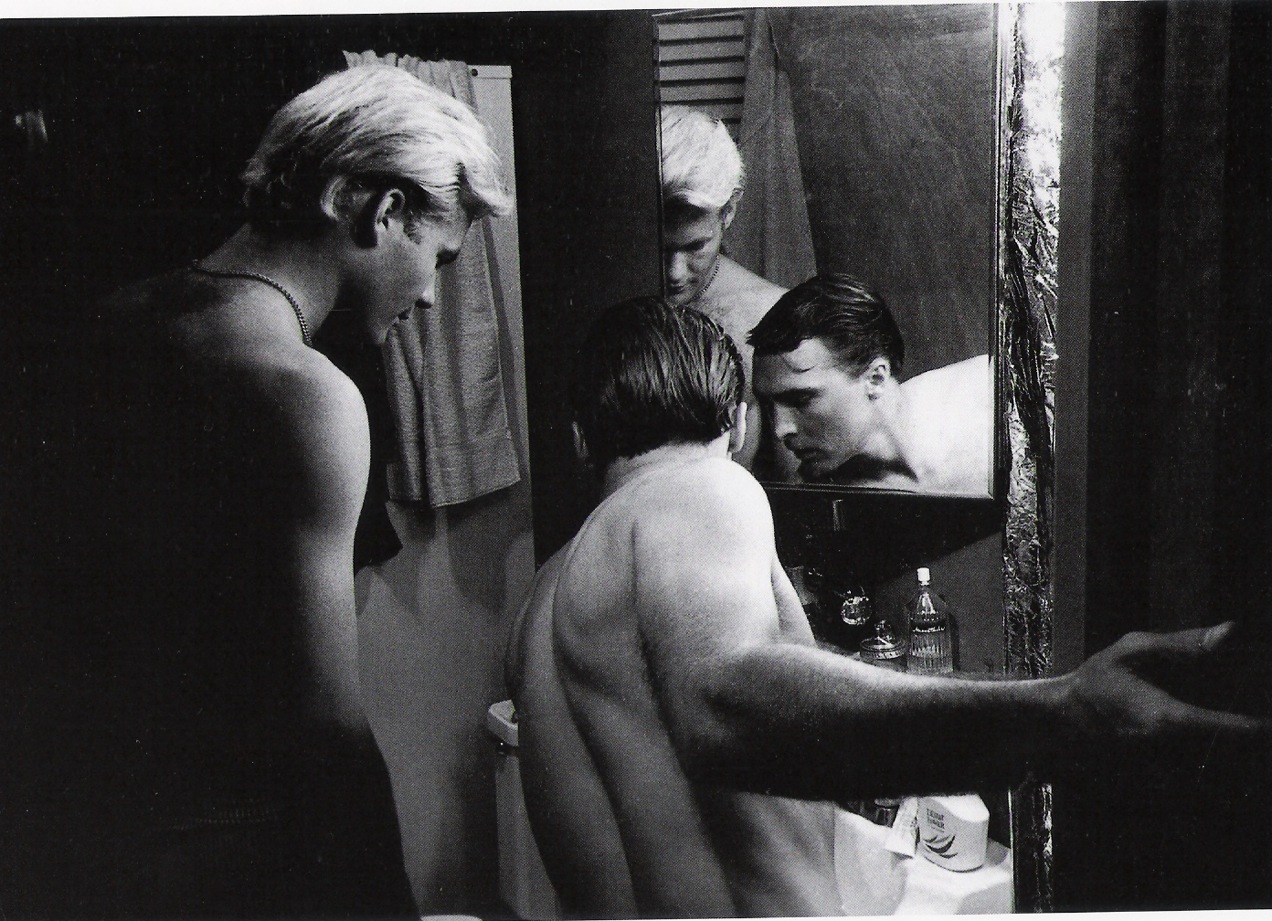
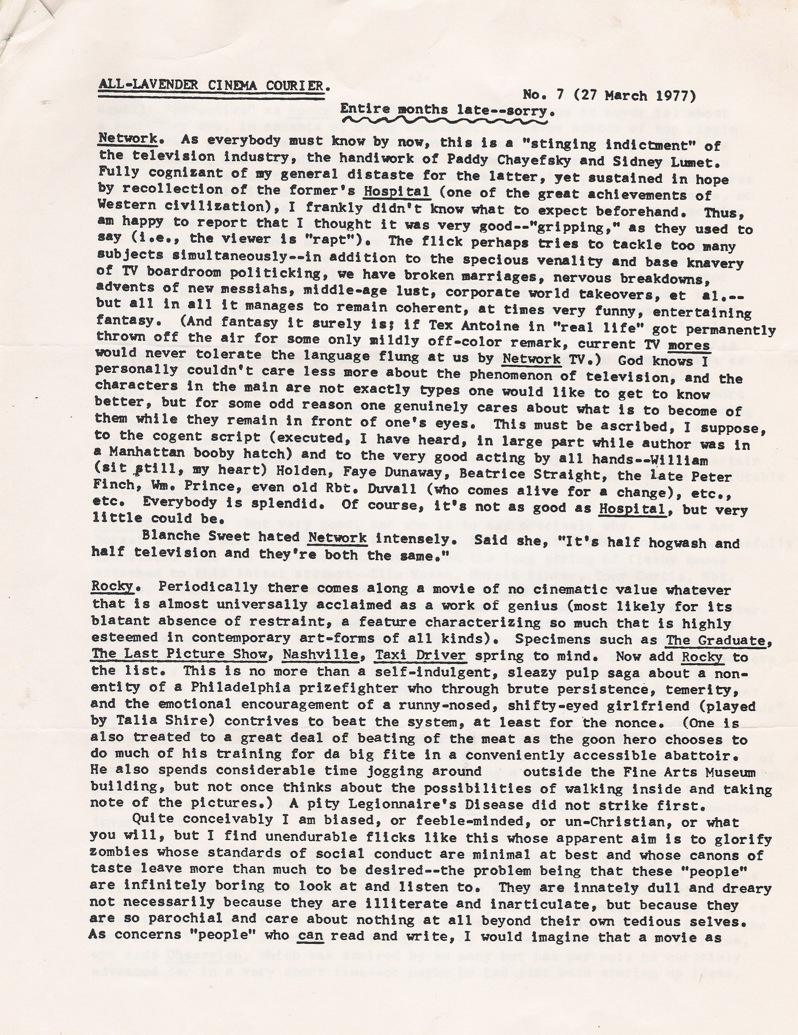





 Now available in North America
Now available in North America 